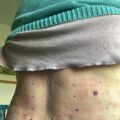Patch tests are a way of exploring and pinpointing atopic contact allergens that could be affecting your skin in everyday life e.g. perfumes, washing powders, preservatives and cosmetics to name just a few. They are a safe, natural and non-invasive treatment and can help you identify many things that have been irritating your skin.
How does patch testing work?
The procedure involves three visits to the allergy clinic:
- 1st visit – An initial application, usually first thing on a Monday morning.
- 2nd visit – Usually midweek (after approx. 48 hours) where the plasters are removed for examination for any reactions. More plasters may be applied on a different part of your back if further tests are needed.
- Final visit – Usually on a Friday. This should show if any of the reactions were particularly strong.
Advice for patch testing
You’ll be given a handout explaining what do to and what not to do, but here are a few things that you should know:
- Avoid strenuous exercise as this may dislodge patches.
- Once the patches have been applied you are advised not to get the patches wet in the bath or shower. Just stick to a pits and bits wash while they are on and for the duration of the testing.
- You will probably be very itchy – you must avoid scratching and rubbing the plasters.
- Be prepared for not finding any answers. Whilst they can be very irritating, they will only diagnose real allergies which will cause a severe reaction. They do not tell you everything you were irritated by, this is just normal, they say! Not always very helpful when your whole back is in an agony of itching.
- Be aware that could get what they call ‘angry back’ which can cloud any answers.
- You could also be allergic to the glue in the plasters and the metal in the little discs used to administer each allergen.
What do the patches look like?
The patches consist of quite large strips of plaster, which can be restricting for movement and itchy just because you have atopic skin. The strips of plaster have small stainless steel discs set into them and a small amount of each allergen is put into the disc so that on application the substance is in direct contact with your skin. These large strips of sticky plaster are applied vertically down the back and upper arms. The nurse then marks with a pen along the edge so that they can easily identify what caused any reactions when the plasters are removed.
Are patch tests suitable for everyone?
If the skin on your arms and back is covered in eczema you may be asked to come back when you’ve healed a little. You do need clear skin to do these tests. You may be given a course of topical steroids to help you clear your skin. I cannot advise this as I have had to go through topical steroid withdrawal. Ideally the dermatologists would like your back to be clear before commencing tests. You will probably be advised to stop using steroids for 3-4 weeks before testing, with the hope the skin will stay clear so the tests can be done.
More information about patch testing
The picture on the right shows the ink used to mark the back. Be prepared for this ink to remain visible for some days afterwards! Mine were still there two weeks later, even after regular soaping and scrubbing.
- Patch Testing for allergies – a medical study
- Read more about patch tests and other treatments and conditions on the British Association of Dermatology website.
I have also written more on this going into more detail of more recent patch testing, ‘My patch testing results – testing for allergens to help avoid eczema triggers‘.
Who should consider patch testing for allergies?
If you think you are reacting to things like shampoos, cleansers, preservatives etc. speak to your doctor about having some patch tests done. It may also help even if you don’t think you have allergies. Contact allergens can build up over time and might not cause an instant reaction.
Things I learnt from my first patch testing experience
I can’t say I enjoyed having it done but I learnt some things from doing it:
- It is difficult keeping the area dry for a week, but there are worse things that could happen,
- You might uncover some answers and be able to avoid irritants in the future.
- It did make me realise that I probably shower too often. My skin did benefit from a period of rest from daily showering and bathing. As a child we used to wash at the basin with a flannel and bar of soap. What would we do without showers now?
- It was possible to not itch where the plasters were, so can I try to scratch less now they are gone?
Have you had patch tests? Let me know about your experiences and what you think about these tests.













I didn’t realize that patch testing on the skin was a way to test for allergies. My little brother always has a stuffy nose, so we’ve been trying to figure out what he’s allergic to. I’ll share this with him, and hopefully we can get some things figured out for him. Do you have any recommendations for finding an allergy doctor?
Hi there, I’m so sorry I missed this comment. 2018 was a difficult year for me! It’s now more than two years since you commented…so sorry. What country do you live in? I’d suggest visiting the charity website for Allergy UK to find recommendations of allergy doctors year you. The NHS also have a search tool if you live in the UK https://www.nhs.uk/service-search/other-services/Allergy/LocationSearch/220